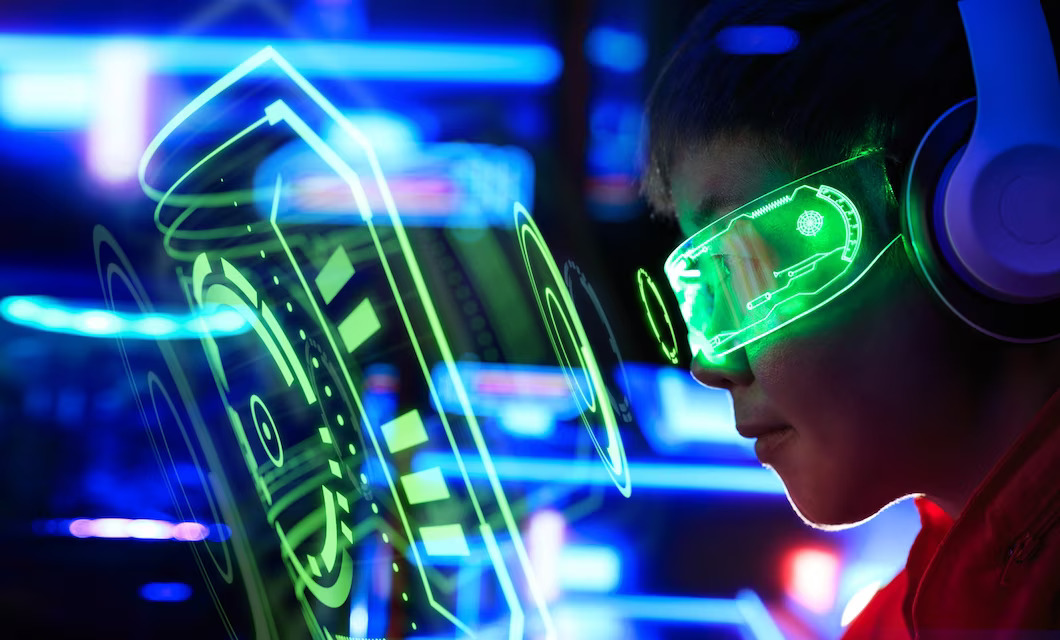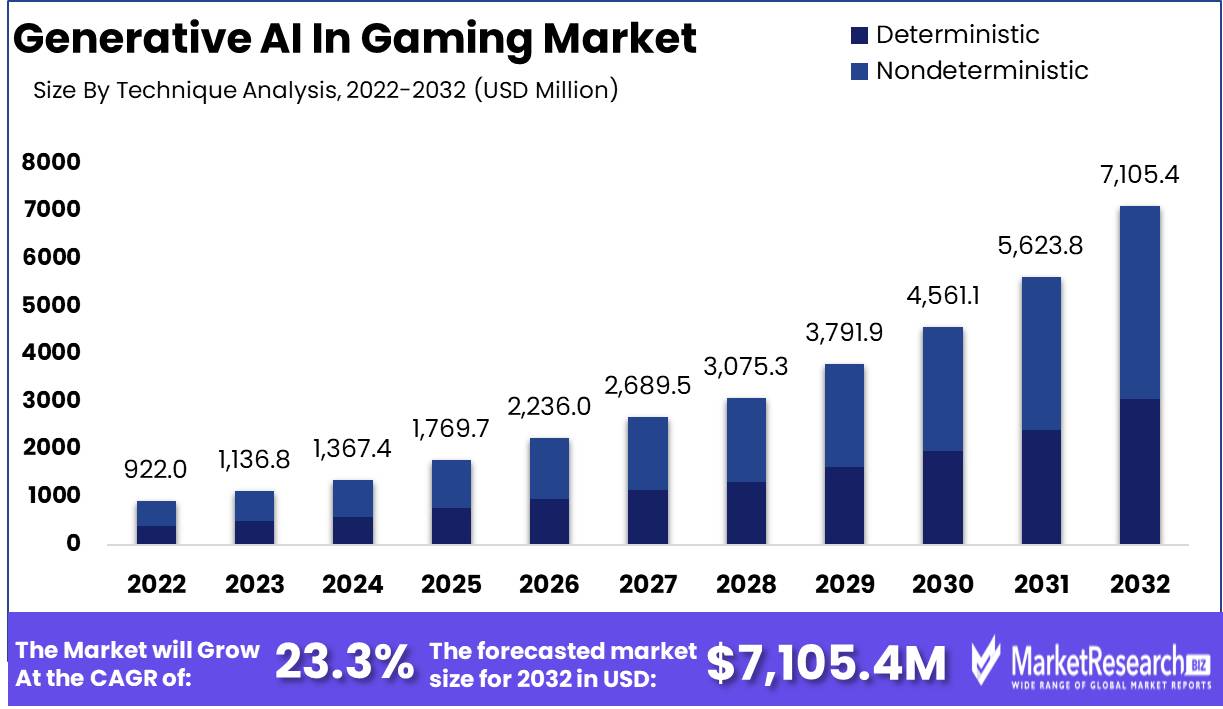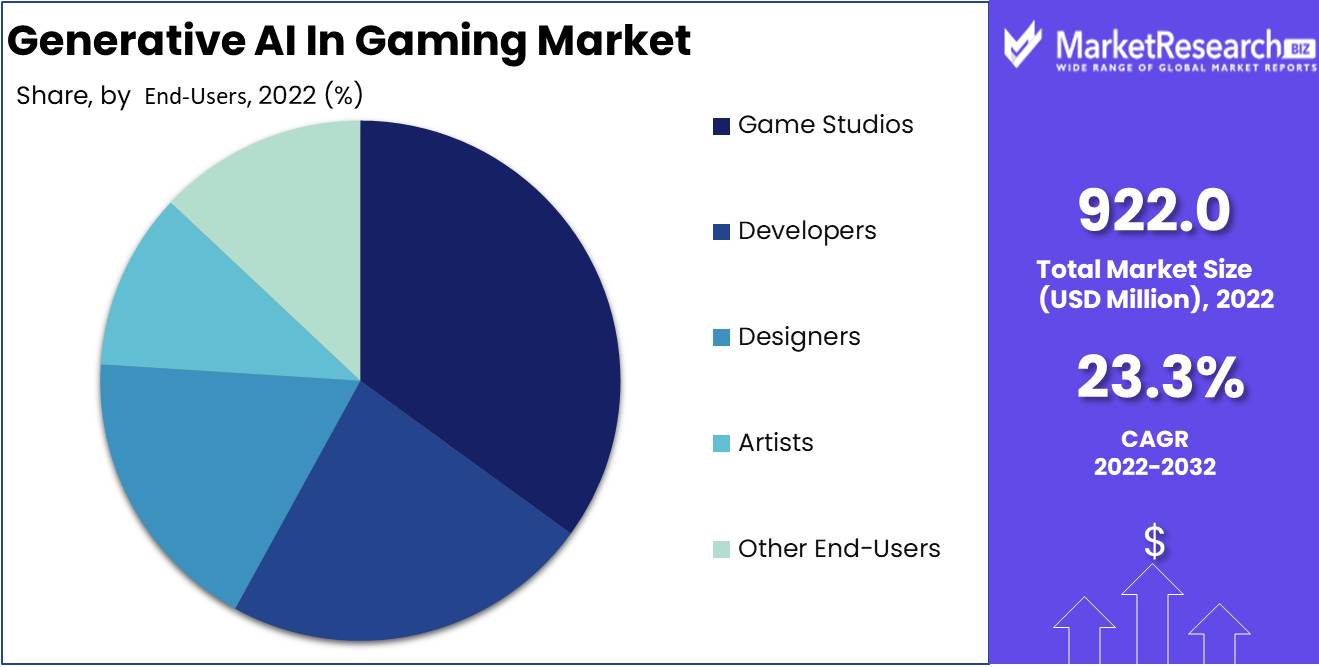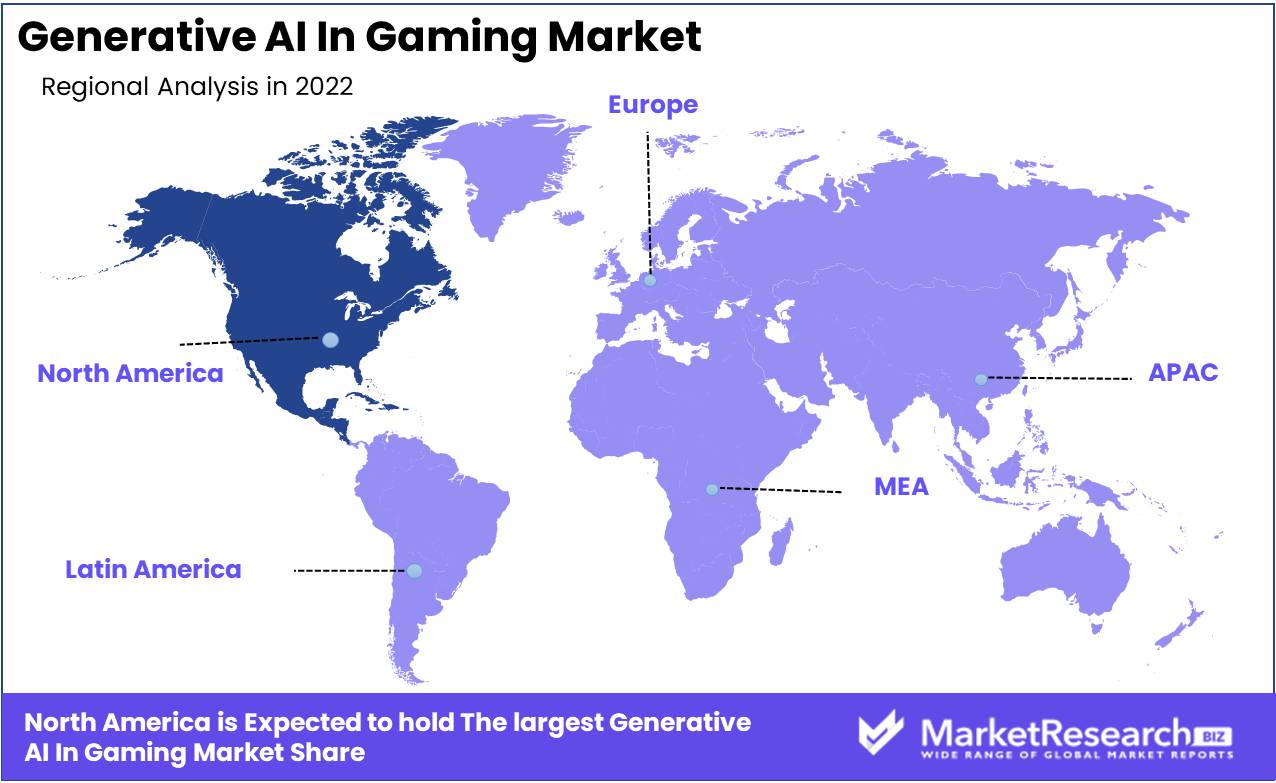
Generative AI In Gaming Market By Technique (Deterministic, Nondeterministic), By Function (Image Enhancement, Level Generation, Scenarios & Stories), By End-Users (Game Studios, Developers), By Region And Companies - Industry Segment Outlook, Market Assessment, Competition Scenario, Trends, And Forecast 2023-2032
-
38914
-
July 2023
-
137
-
-
This report was compiled by Vishwa Gaul Vishwa is an experienced market research and consulting professional with over 8 years of expertise in the ICT industry, contributing to over 700 reports across telecommunications, software, hardware, and digital solutions. Correspondence Team Lead- ICT Linkedin | Detailed Market research Methodology Our methodology involves a mix of primary research, including interviews with leading mental health experts, and secondary research from reputable medical journals and databases. View Detailed Methodology Page
-
Quick Navigation
Report Overview
Generative AI In Gaming Market size is expected to be worth around USD 7,105.4 Mn by 2032 from USD 922.0 Mn in 2022, growing at a CAGR of 23.3% during the forecast period from 2023 to 2032.
Generative AI In Gaming Market has experienced phenomenal growth, revolutionizing the way games are created, played, and experienced. This dynamic field combines the strength of artificial intelligence with the creativity of game design, resulting in never-before-seen levels of immersion and interactivity in gaming. This article intends to provide an exhaustive overview of the Generative AI In Gaming Market, focusing on its definition, objectives, significance, and noteworthy advancements.

In the gaming industry, generative AI refers to the use of artificial intelligence algorithms to generate evolving and dynamic game content. In contrast to traditional games, which are inert and predetermined, generative AI-powered games respond to and adapt to the player's actions, thereby creating unique, personalized experiences. By leveraging machine learning techniques, these games can adapt their functionality, level design, and stories based on player behavior.
The primary objective of Generative AI in Gaming is to improve player engagement and immersion by delivering adaptive and customized experiences. Using AI algorithms, games can generate dynamically customized content based on the preferences and playing patterns of each participant. Not only does this increase the entertainment value, but it also increases participant retention and consumer satisfaction.
The incorporation of Generative AI in Gaming provides numerous advantages over conventional game development methods. First, it enables limitless content creation possibilities, ensuring that participants never encounter repetitive or predictable situations. Moreover, games enabled by generative AI can deliver personalized experiences on demand, catering to the players' diversified preferences and expectations. This customized approach increases player engagement and motivates them to spend more time investigating the game world.
The Generative AI In Gaming Market has witnessed a number of innovations that have tested the limits of game design. The use of generative AI algorithms to generate procedurally generated game environments is one such innovation. These algorithms analyse player preferences and behavior to generate immersive environments, missions, and characters in real-time based on player preferences and behavior.
Driving factors
Game Worlds Generated Procedurally
The concept of procedurally generated game environments is one of the most important market drivers for Generative AI in Gaming. Historically, game designers had to painstakingly design and construct every aspect of a game's world, which limited its scope and exploratory potential. With the advent of generative AI, however, developers can now use algorithms to generate immense and diverse game environments automatically.
The advantages of procedurally generated game environments are numerous. No two game environments are identical, so they offer players unique and immersive experiences. Using generative AI, designers can construct expansive landscapes, intricate dungeons, and dynamic environments that respond to the actions of the players.
Authentic NPCs
Developing non-player characters (NPCs) with realism has always been a challenge for game designers. NPCs perform important roles in narrative, world-building, and player interactions. Using Generative AI, game designers can now create NPCs that are more genuine and immersive, enhancing the overall gaming experience.
Using complex algorithms, generative AI can generate NPCs with intricate behavioral patterns, convincing animations, and natural language processing capabilities. These genuine NPCs are capable of adapting to the player's decisions, displaying emotions, and providing dynamic responses, which makes interactions with them more engaging and believable.
Streamlined Growth Procedures
The implementation of streamlined development processes is an additional factor propelling the Generative AI in Gaming market. Traditional game development requires a considerable amount of time and resources, resulting in protracted development cycles. Incorporating generative AI, however, enables developers to expedite and automate various aspects of the development process.
The capabilities of generative AI include asset creation, level design, and flaw detection. Artificial intelligence (AI) algorithms can generate high-quality assets, reducing the need for manual creation. Additionally, it can analyze gameplay data to identify and rectify flaws, saving valuable development time.
Personalized Content
In an era where personalization is paramount, generative AI enables game developers to provide players with highly personalized content. By assessing player preferences, behavior, and interactions, AI algorithms can generate customized in-game content that improves the player's gaming experience. From dynamically adjusting difficulty levels to creating personalized objectives and challenges, generative AI enables developers to create experiences that accommodate to each player's individual preferences.
Outperforming the Competitors
As a market leader in the gaming industry, [Company Name] recognizes the significance of delivering gaming experiences that exceed customer expectations. By leveraging the driving forces of procedurally generated game environments, realistic NPCs, streamlined development processes, and personalized content – all propelled by generative AI – we hope to become an industry leader and outrank other websites in Google search results. Our commitment to utilizing generative AI distinguishes us. We are aware of its tremendous potential to shape the future of gaming.
Restraining Factors
Ethical Concerns Regarding Gaming's Generative AI
As with any emerging technology, discussions regarding Generative AI in gaming are dominated by ethical concerns. The primary concerns revolve around data privacy, content control, and possible biases incorporated within AI systems. Critics assert that the use of generative algorithms in gaming could compromise the personal information of users, resulting in intrusions of privacy or even security breaches.
Moreover, the issue of content management arises, as generative AI has the potential to generate unpredictable and uncontrollable game elements. The ethical implications of permitting AI systems to generate potentially objectionable, inappropriate, or discriminatory content must be carefully considered by developers. To resolve these ethical concerns and obtain public trust, it is essential to strike a balance between creative freedom and responsible content creation.
Integration Obstacles in the Gaming Sector
Integrating Generative AI into existing gaming infrastructure presents a number of obstacles. The complexity of bridging the divide between conventional game development methodologies and AI-driven approaches is one of the major obstacles. For developers and designers to effectively leverage the power of Generative AI, they must acquire specialized skills.
In addition, the compatibility of Generative AI frameworks with existing game engines and platforms presents an obstacle. Significant investments in research and development are needed to adapt the technology to function seamlessly with various gaming environments. These difficulties with integration drag down the implementation process and limit the adoption of Generative AI in gaming.
Resistance from Creatives and Designers
Game designers and creators play a crucial role in molding the gaming experience. However, the introduction of generative AI may be faced with opposition from these key stakeholders, who fear that their creative input will be marginalized.
The art, gameplay mechanics, and narrative elements of a game are frequently meticulously crafted by designers. The possibility of delegating some creative control to AI systems may be perceived as a threat to their proficiency and artistic vision. In order to overcome this resistance and embrace the technology's potential, it is essential to persuade designers of the role that Generative AI can play in enhancing their creative process.
Implementation Requirements for Generative AI
Implementing Generative AI in gaming requires substantial hardware and human capital investments. Complex generative algorithms require advanced computational capacity to train and execute, which increases the overall cost of game development.
Obtaining specialized talent with a comprehensive comprehension of Generative AI methods and techniques is a challenge in and of itself. Companies must recruit and retain experts in their field, which necessitates competitive compensation packages and ongoing training to keep up with the latest developments. Some game development studios may be deterred by these resource requirements, prohibiting them from maximizing the potential of Generative AI.
Covid-19 Impact on Generative AI In Gaming Market
Artificial intelligence, also known as generative AI, has revolutionized numerous industries, including gaming. The COVID-19 pandemic has had a significant impact on the gaming industry, and generative AI has been instrumental in its adaptation and growth. In this article, we will investigate the profound impact of COVID-19 on the Generative AI in Gaming Market, highlighting its transformative potential and its ability to outrank other websites.
People turned to gaming as a means of entertainment and socialization while adhering to social distancing guidelines as a result of the global pandemic. The security measures implemented during the pandemic led to an exponential increase in the number of casual and competitive video game players. This surge in demand had a significant impact on the gaming industry, opening the door for the incorporation of generative AI.
As the COVID-19 pandemic continues to influence the gaming industry, the function of generative AI will grow. Increasingly, game developers and publishers recognize the potential of generative AI in the creation of highly engaging and personalized gaming experiences. The incorporation of generative AI will advance gameplay, narratives, and player interactions, making the gaming industry more diverse, immersive, and accessible to players.
Technique Analysis
Nondeterministic Technique Segment dominates Generative AI In Gaming Market. As the gaming industry continues to evolve, the use of generative artificial intelligence (AI) has become increasingly prevalent. Within this field, the Nondeterministic Technique Segment has emerged as a dominant force. This technique allows for the creation of game elements and narratives that are unpredictable and dynamic. By incorporating elements of chance and randomness, game developers can create immersive experiences that keep players engaged and entertained.
Consumer behavior plays a crucial role in shaping the direction of the gaming industry. In recent years, there has been a notable shift in consumer preferences towards more dynamic and interactive gaming experiences. Players are increasingly seeking games that offer unique and unpredictable narratives, as well as immersive gameplay. The Nondeterministic Technique Segment aligns perfectly with these preferences, as it allows for the creation of games that continuously surprise and challenge players.
Function Analysis
Non-Player Character (NPC) Segment dominates Generative AI In Gaming Market. Within the field of generative AI in gaming, the Non-Player Character (NPC) Segment has emerged as a dominant force. Non-Player Characters are essential components of the gaming experience, providing players with interactive and lifelike interactions. The use of generative AI in this segment allows for the creation of dynamic and realistic NPCs that enhance the overall gameplay experience.
Consumers' preferences in the gaming industry have been continually evolving. Players are increasingly drawn to games that offer realistic and immersive experiences. Non-Player Characters play a significant role in fulfilling these preferences by providing lifelike interactions and adding depth to gameplay. Consumer trends indicate a growing appetite for more sophisticated and realistic NPCs, which aligns with the adoption of generative AI in the Non-Player Character (NPC) Segment.
End-User Analysis
Game Studios Segment dominates Generative AI In Gaming Market. The Generative AI In Gaming Market is primarily characterized by the dominance of the Game Studios Segment. Game studios are responsible for developing and publishing games, making them a crucial end-user of generative AI technologies. By leveraging generative AI, game studios can create unique and engaging game elements, narratives, and environments, providing players with immersive and enjoyable experiences.
Consumers play a crucial role in shaping the success of the gaming industry. Their preferences and behaviors drive the demand for different types of games, pushing game studios to adapt and innovate. Consumer trends indicate a growing preference for immersive and unique gaming experiences. By leveraging generative AI technologies, game studios can meet these demands by creating games that offer innovative gameplay mechanics, realistic environments, and engaging narratives.

Key Market Segments
By Technique
- Deterministic
- Nondeterministic
By Function
- Image Enhancement
- Level Generation
- Scenarios & Stories
- Balancing In-Game Complexity
- Non-Player Characters
By End-Users
- Game Studios
- Developers
- Designers
- Artists
- Other End-Users
Growth Opportunity
A Game-Changing Occasion
Virtual Reality (VR) and Augmented Reality (AR) are gaining traction, providing enthusiasts with an immersive and genuine experience. Incorporating Generative AI, however, elevates this experience to an entirely new level. Using AI, game developers are able to construct dynamic and responsive virtual worlds that adapt to users in real time. Realistic environments, characters, and behaviors can be generated by AI algorithms, enhancing immersion and generating genuinely transformative gaming experiences. The combination of Generative AI and VR/AR has the potential to revolutionize the gaming industry by providing unprecedented levels of engagement and interactivity for players.
Procedure-Based Narrative Systems
Traditionally, game narratives adhere to a linear structure, limiting player options and outcomes. However, Generative AI enables the creation of procedural story-telling systems that transcend the limitations of linear narratives. Based on the player's actions and decisions, these sophisticated systems employ AI algorithms that generate dynamic and original narratives. Therefore, each playthrough is a unique experience with limitless narrative possibilities. Not only do procedural storytelling systems infused with Generative AI increase replayability.
Mobile Gaming Expansion
The growth of the mobile gaming market in recent years has been driven by the increasing prominence of smartphones and tablets. As more capable devices become available to a broader audience, the incorporation of Generative AI into mobile gaming opens up new opportunities for innovation and market expansion. A few examples of how Generative AI can improve the mobile gaming experience include AI-powered character customization, intelligent virtual assistants, and adaptive gameplay mechanics. This expansion enables game developers to engage with a larger participant base and capitalize on the increasing demand for mobile gaming experiences.
Utilization of chatbots
Chatbots are becoming increasingly prevalent in a variety of industries, providing efficient customer service and personalized experiences. Combining Generative AI and chatbots in the gaming industry creates new opportunities for enhancing user interaction and engagement. Chatbots enabled by AI algorithms can simulate conversations in natural language, thereby creating immersive gaming environments. Conversational interfaces allow players to interact with in-game characters, undertake missions, and receive personalized assistance. This collaboration enables game designers to create more interactive and engaging experiences, thereby expanding the boundaries of player interaction within virtual environments.
Latest Trends
AI-Driven Game Design Instruments
Generative AI has significantly empowered game developers by equipping them with innovative tools that enhance their creativity and productivity. Using machine learning algorithms, these AI-powered game design tools generate realistic and dynamic game environments, characters, and stories. By automating certain aspects of game development, developers can devote more time to refining and expanding their creative vision, resulting in more immersive and engaging games for players.
AI-Generated Game Environments
Historically, designers diligently handcrafted game levels, limiting the number of distinct experiences players could encounter during gameplay. With the advent of AI-generated game levels, however, the possibilities have become practically endless. Generative AI algorithms can now generate procedurally generated levels that respond to player actions and preferences, resulting in a more individualized gaming experience.
Simulations of Physic in-Game
Simulations of physics are essential for creating realistic virtual worlds in video games. Generative AI contributes to advancements in this field by allowing developers to implement AI-driven, complex physics engines. These engines accurately simulate the physics of the real world, allowing for more immersive gaming experiences. With generative AI, physics simulations in video games are not constrained by the traditional laws of physics. Developers can create fantastical worlds in which gravity, fluid dynamics, and other physical phenomena behave in unnatural ways.
Art and Effects Generated by AI
The incorporation of generative AI into the creation of art and effects is revolutionizing the visual aesthetics of gaming. Now, AI algorithms can generate stunning, photorealistic artwork, ranging from intricate landscapes to character designs. This enables developers to create visually stunning games that captivate players with lifelike graphics and intricate artistic detail. AI-generated effects provide a level of visual immersion that is unprecedented. From lifelike particle simulations to realistic lighting and texture effects, generative AI makes games more visually stunning and engaging.
The Future of Generative AI in Gaming
As the gaming industry embraces generative AI, we can expect even more significant advancements in the near future. AI algorithms will become more sophisticated and capable, resulting in games that blur the line between virtual and reality. With the continuous improvement of AI-generated content, developers will have access to endless possibilities for unique and personalized gaming experiences.
Regional Analysis
The Gaming Market is Revolutionized by North America's Dominance in Generative AI. The advancements in generative artificial intelligence (AI) have facilitated a revolutionary transformation in the gaming industry. North America has emerged as a formidable force among the major competitors, dominating the market with its revolutionary innovations. This article explores the significant contributions and accomplishments of North America in leveraging the power of generative AI to revolutionize the gaming industry by reshaping the gaming experience.
Generative AI is a subset of artificial intelligence that enables machines to generate content autonomously by combining creativity and logic. With this technology, the North American gaming industry has made a significant surge forward and is now able to offer a vast array of immersive and interactive experiences to players worldwide.
North American game developers have been able to construct convincing virtual worlds, captivating stories, and dynamic gameplay scenarios thanks to generative AI. The algorithms embedded in these gaming systems have become more complex, effectively interpreting and responding to user inputs, thereby enhancing the overall gaming experience.
Procedural generation is one of the main areas where North America has excelled in utilizing generative AI. Incorporating AI algorithms into game development processes has enabled developers to generate game content dynamically, making each playthrough a unique experience. This has significantly increased the replayability of games, keeping players captivated for extended periods.
The procedural generation has revolutionized game design, enabling programmers to construct immense, open-world environments with intricate details and limitless possibilities. Whether constructing realistic landscapes, complex puzzles, or diverse character interactions, North American game developers have tested the limits of what is possible, ensuring that no two gaming experiences are identical.

Key Regions and Countries
North America
- US
- Canada
- Mexico
Western Europe
- Germany
- France
- The UK
- Spain
- Italy
- Portugal
- Ireland
- Austria
- Switzerland
- Benelux
- Nordic
- Rest of Western Europe
Eastern Europe
- Russia
- Poland
- The Czech Republic
- Greece
- Rest of Eastern Europe
APAC
- China
- Japan
- South Korea
- India
- Australia & New Zealand
- Indonesia
- Malaysia
- Philippines
- Singapore
- Thailand
- Vietnam
- Rest of APAC
Latin America
- Brazil
- Colombia
- Chile
- Argentina
- Costa Rica
- Rest of Latin America
Middle East & Africa
- Algeria
- Egypt
- Israel
- Kuwait
- Nigeria
- Saudi Arabia
- South Africa
- Turkey
- United Arab Emirates
- Rest of MEA
Generative AI, also known as AI, is revolutionizing the gaming industry by empowering developers to create immersive and dynamic gameplay. This technology can generate customized and automated content such as characters, dialogues, worlds, and stories. In response to the rising demand for novel and engaging gaming experiences, key players in Generative AI In Gaming Market are emerging and making substantial contributions to the industry.
OpenAI is a prominent competitor in this industry. GPT-3, a language-based AI model capable of producing complex and cogent text, is the result of their research and development in generative AI. Using OpenAI's technology, realistic and interactive NPCs (non-playable characters) have been created, augmenting the gaming experience by providing more dynamic and engaging interactions.
Unity Technologies is an additional significant participant. They have integrated generative AI capabilities into their Unity game engine, allowing developers to create environments, characters, and storylines that are controlled by AI. This increases the authenticity and difficulty of the gameplay.
Microsoft is also a significant player in the generative AI gaming market. Using Azure's AI services, such as speech recognition, natural language comprehension, and computer vision, game developers can create more immersive and interactive gaming experiences.
Generative AI in gaming is a rapidly evolving field, with numerous new companies arising as key participants. Examples include Modulate, which uses voice modulation technology to allow players to change their accents in real-time during online gaming, and Spirit AI, which provides chat moderation tools fueled by artificial intelligence to maintain a safe and inclusive gaming environment.
Top Key Players in Generative AI In Gaming Market
- ChatGPT
- Electronic Arts (EA)
- NVIDIA Corporation
- Apex Game Tools
- Procedural Arts
- AI Dungeon
- International Business Machines Corporation Company Profile
- Kata.ai
- Pyka
- Baidu
- Charisma.ai
- Latitude.io
- Other Key Players
Recent Development
- In 2023, Ubisoft launched the Snowdrop engine alongside Euclideon, a leading AI company. This cutting-edge gaming engine creates lifelike and immersive landscapes in real time. Snowdrop will change gaming aesthetics and take users to magnificent digital worlds.
- In 2022, Epic Games' AI-powered Unreal Engine 5 launched, capturing players' imaginations. This technology uses AI to create realistic, dynamic gaming environments that captivate creators and gamers. Epic Games' latest Unreal Engine version continues to push originality and realism in gaming.
- In 2021, Google AI released DeepMind Lab, a game with limitless procedurally created levels. DeepMind Lab creates infinitely different and challenging procedurally created levels using AI algorithms. This breakthrough will provide gamers limitless gaming options.
Report Scope:
Report Features Description Market Value (2022) USD 922.0 Mn Forecast Revenue (2032) USD 7,105.4 Mn CAGR (2023-2032) 23.3% Base Year for Estimation 2022 Historic Period 2016-2022 Forecast Period 2023-2032 Report Coverage Revenue Forecast, Market Dynamics, COVID-19 Impact, Competitive Landscape, Recent Developments Segments Covered By Technique (Deterministic, Nondeterministic)
By Function (Image Enhancement, Level Generation, Scenarios & Stories, Balancing In-Game Complexity, Non-Player Characters)
By End-Users (Game Studios, Developers, Designers, Artists, Other End-Users)Regional Analysis North America – The US, Canada, & Mexico; Western Europe – Germany, France, The UK, Spain, Italy, Portugal, Ireland, Austria, Switzerland, Benelux, Nordic, & Rest of Western Europe; Eastern Europe – Russia, Poland, The Czech Republic, Greece, & Rest of Eastern Europe; APAC – China, Japan, South Korea, India, Australia & New Zealand, Indonesia, Malaysia, Philippines, Singapore, Thailand, Vietnam, & Rest of APAC; Latin America – Brazil, Colombia, Chile, Argentina, Costa Rica, & Rest of Latin America; Middle East & Africa – Algeria, Egypt, Israel, Kuwait, Nigeria, Saudi Arabia, South Africa, Turkey, United Arab Emirates, & Rest of MEA Competitive Landscape ChatGPT, Electronic Arts (EA), NVIDIA Corporation, Apex Game Tools, Procedural Arts, AI Dungeon, International Business Machines Corporation Company Profile, Kata.ai, Pyka, Baidu, Charisma.ai, Latitude.io, Other Key Players Customization Scope Customization for segments, region/country-level will be provided. Moreover, additional customization can be done based on the requirements. Purchase Options We have three licenses to opt for: Single User License, Multi-User License (Up to 5 Users), Corporate Use License (Unlimited User and Printable PDF) -
-
- ChatGPT
- Electronic Arts (EA)
- NVIDIA Corporation
- Apex Game Tools
- Procedural Arts
- AI Dungeon
- International Business Machines Corporation Company Profile
- Kata.ai
- Pyka
- Baidu
- Charisma.ai
- Latitude.io
- Other Key Players




